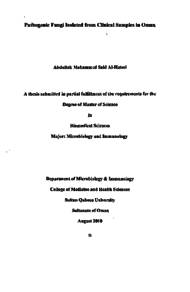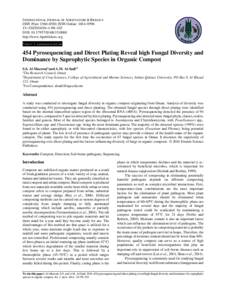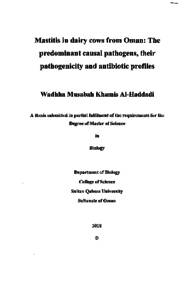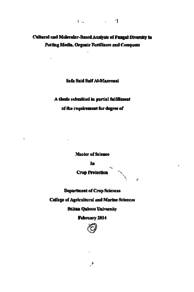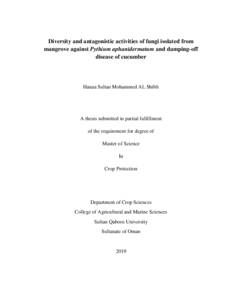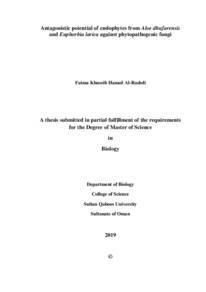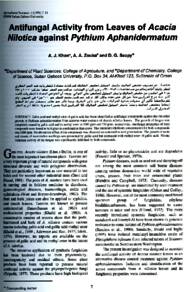Document
Pathogenic fungi isolated from clinical samples in Oman
Publisher
Sultan Qaboos University
Gregorian
2010
Language
English
English abstract
Background: Infections caused by pathogenic fungi have increased in recent years and well recognized to be one of the important causes of death especially in immunocompromised patients. The diagnosis of fungal infections remains a significant problem, mainly because cultures are slow-growing and identification is laborious and difficult, especially for moulds. However, rapid identification of pathogenic fungi is essential to start antifungal treatment. Conventional identification of moulds is mainly performed by phenotypic criteria, including micro- and macromorphology. Phenotypic identification procedures are time consuming and require expertise in fungal morphology. However, specialists and expertise in medical mycology field are decreasing due to several reasons, requiring the application of easy genetic assays such as PCR-sequencing, PCR-RFLP and PCR-fingerprinting. These techniques are successfully applied to identify pathogenic fungal isolates (moulds and Yeasts).
Methods: We previously identified 70 fungal strains by conventional methods such as culture, microscopy and biochemical tests. Then, DNA was isolated from pure cultures of fungi by simple and rapid chemical (phenol: chloroform: isoamylmalcohol) based DNA extraction protocol. PCR method for identification of pathogenic fungi based on the amplification of the Internal Transcribed Spacer (ITS1/2) region was used. After the PCR products were sequenced, GenBank Blast searches were performed, and the sequence-based and conventional identifications were compared. We also decided to identify our fungal strains by using ITS-RFLP and PCR-fingerprinting.
Results: In this study, our data showed that we were able to identify 13 mould strains up to the species level and 7 mould strains up to the genus level. 20 different species of moulds were identified by conventional techniques; the most common were dermatophytes (42.2%) followed by Aspergillus species (40%) and some other miscellaneous moulds (18.8%). 45 mould strains belonged to 20 genera investigated in this study included 12 Aspergillus niger and 9 dermatophyte isolates. 13.3% of the total number of moulds studied were not identified to the species level. The most frequent identifications of 25 strains of yeasts were as following: Candida tropicalis (9/25), followed by Candida albicans (7/25), Candida glabrata (4/25), Geotrichum capitatum (3/25) and Candida parapsilosis (2/25). By contrast, 65 fungal strain were identified by PCR- sequencing and showed that 64 (98.4%) identified to species level and 1 (1.6%) to genus level. Also PCR-RFLP showed (100%) similarity to the identification by ITS sequencing and (82.9%) with culture results. There was 100% agreement between the PCR-RFLP analyses and PCR-fingerprinting analyses for the identifications obtained of the studied Candida species.
Conclusions: Conventional methods of identification of fungi have mainly relied on culture isolation and the observations of morphological features. These methods are time consuming, laborious, and may require days to weeks for the identification by culture. PCR of the ITS region followed by sequencing can be used to identify pathogenic fungal organisms in pure culture but it is expensive. Analysis of the ITSRFLP can be an alternative tool for a fast and reliable identification of fungi in microbiological laboratories. In addition, PCR-fingerprinting analysis is not only faster and simple to use, but useful given its consistency with conventional methods.
Member of
Resource URL
Arabic abstract
الخلفية : العدوى الناجمة عن الفطريات المسببة للأمراض زادت في السنوات الأخيرة وأيضا عرفت على انها أصبحت و بشكل كبير واحدة من الأسباب المؤدية للوفاة وخاصة في المرضى الذين يعانون من ضعف المناعة تشخيص الأمراض الفطرية لا يزال يمثل مشكلة كبيرة ويرجع ذلك أساسا إلى أن هذه الفطريات بطيئة النمو في المستنبتات الزراعيه وايضا تحديد وتعريف هذه الفطريات بجهاز الميكرسكوب صعبة ، وخاصة بالنسبة اللاعفان. ومع ذلك إلا إن التعرف السريع على الفطريات المسببة للأمراض لا بد منه وخاصة عند بدء العلاج بالمضادات الفطرية. إن تحديد أنواع الأعفان بالطرق التقليدية تتم أساسا وفقا للمعايير المظهرية للعفن ، بما في تلك micro morphology وmacro morphology. و أيضا إجراءات تحديد الهوية المظهرية للفطر تستغرق وقتا طويلا وتتطلب خبرة في الأنواع الفطرية. ومع ذلك فإن إعداد المتخصصين والخبراء في مجال علم الفطريات الطبية آخذة في التناقص نتيجة لأسباب عدة مما جعل تطبيق الفحوصات الجينية للأعفان المرضية سهلة مثل:PCR - sequencing و PCR - RFLP و PCR - fingerprinting وتطبق بنجاح هذه التقنيات لتحديد العدوى الفطرية المعزولة (العفن والخمائر)
الطرق : في هذا البحث سبق وأن تم تحديد ۷۰ سلالة من السلالات الفطرية بالطرق التقليدية مثل المستنبتات الزراعية والفحوصات المجهرية والاختبارات الكيميائية الحيوية. ثم بعد ذلك تم عزل الحمض النووي DNA من المستنبتات النقية من الفطريات بطرق كيميائية بسيطة وسريعة مثل (الفينول : كلوروفورم) على اساس بروتوكول استخراج الحمض الريبي النووي. ثم بعد ذلك تم استخدام طريقة PCR لتحديد الفطريات المسببة للأمراض على أساس عملية تسمي ITS - sequencing . واجريت عمليات تفتيش في بنك الجينات للتعرف الدقيق على هذه الفطريات واخيرا تمت مقارنة وتحديد هوية الفطريات بالمقارنة بين الطرق الجينية والتقليدية كما قررنا أيضا في هذا البحث استخدام طرق جينية أخرى مثل طريقة PCR -RFLP وطريقة.-PCR fingerprinting لتحديد السلالات الفطرية لدينا.
النتائج : في هذه الدراسة أظهرت البيانات المتوفرة لدينا أننا تمكنا من تحديد ۱۳ سلالة من الأعفان حتی مستوى النوع و ۷ سلالات من الأعفان حتى مستوى الجنس. وقد تم تحديد ۲۰ نوعا مختلفا من الفطريات السامة بالتقنيات التقليدية ووجد أن الأكثر شيوعا هي dermatophytes (۲۲ ) تليها أنواع Aspergillus (40) وبعض أنواع الأعفان الأخرى (۱۸ . ۸ %).وجد أيضا في هذه الدراسة أن 45 سلالة من العفن تنتمي إلى ۲۰ جنسا و هي كالتالي ۱۲نوع من Aspergillus niger و ۹ أنواع من dermatophytes. لم تحدد ( ۱۳. ۳ ) من العدد الإجمالي للأعفان التي درست في هذا البحث على مستوى الأنواع. وأيضا تم التعرف على بعض أنواع الخمائر ووجد أن الأكثر شيوعا من مجموع ۲۰ سلالة على النحو التالي:c , tropicalis (۲۰/۹ )، يليه .C C . albicans (۲۰/ ۹ ) وC . glabrata (۲۰/ ۵ ) وC . parapsilosis ( ۲۰ /۲ ). على النقيض من ذلك تم تحديد 65 سلالة فطرية بواسطة طريقة PCR - sequencing حيث أظهرت أن ۹۶ نوع (98.4 %) تم تحديدها على مستوى الأنواع و۱ فقط (1 . 6 %) إلى مستوي الجنس. وأظهرت أيضا PCR- RFLP ( %۱۰۰) تشابها في تحديد هوية الأعفان مع PCR - sequencing و ( ۸۲.۹ ٪) مع نتائج المستنبتات الزراعية وكان هناك اتفاق ۱۰۰ / بين تحليلات PCR- RFLP وPCR -fingerprinting لتحديد هوية الخمائر Candida species التي شملتها الدراسة.
الخلاصة: أن الطرق التقليدية المستخدمة لتحديد هوية الفطريات تاخذ وقتا طويلا ووجت على انها ايضا عملية شاقة ، وربما تحتاج إلى أيام و أسابيع لعزل وتحديد الفطريات من المستنبتات الزراعية. أيضا استخدام الطرق الجينيه مثل PCR - sequencing لتحديد الكائنات المسببة للأمراض الفطرية دقيقة و نقية ولكنها باهظة الثمن. يمكن استخدام احدى الطرق الجينية مثل PCR- RFLP أوPCR - fingerprinting وهما عمليات سريعة وموثوق بها لتحديد أنوع الفطريات المسببة للأمراض في المختبرات الميكروبيولوجية السريرية.
الطرق : في هذا البحث سبق وأن تم تحديد ۷۰ سلالة من السلالات الفطرية بالطرق التقليدية مثل المستنبتات الزراعية والفحوصات المجهرية والاختبارات الكيميائية الحيوية. ثم بعد ذلك تم عزل الحمض النووي DNA من المستنبتات النقية من الفطريات بطرق كيميائية بسيطة وسريعة مثل (الفينول : كلوروفورم) على اساس بروتوكول استخراج الحمض الريبي النووي. ثم بعد ذلك تم استخدام طريقة PCR لتحديد الفطريات المسببة للأمراض على أساس عملية تسمي ITS - sequencing . واجريت عمليات تفتيش في بنك الجينات للتعرف الدقيق على هذه الفطريات واخيرا تمت مقارنة وتحديد هوية الفطريات بالمقارنة بين الطرق الجينية والتقليدية كما قررنا أيضا في هذا البحث استخدام طرق جينية أخرى مثل طريقة PCR -RFLP وطريقة.-PCR fingerprinting لتحديد السلالات الفطرية لدينا.
النتائج : في هذه الدراسة أظهرت البيانات المتوفرة لدينا أننا تمكنا من تحديد ۱۳ سلالة من الأعفان حتی مستوى النوع و ۷ سلالات من الأعفان حتى مستوى الجنس. وقد تم تحديد ۲۰ نوعا مختلفا من الفطريات السامة بالتقنيات التقليدية ووجد أن الأكثر شيوعا هي dermatophytes (۲۲ ) تليها أنواع Aspergillus (40) وبعض أنواع الأعفان الأخرى (۱۸ . ۸ %).وجد أيضا في هذه الدراسة أن 45 سلالة من العفن تنتمي إلى ۲۰ جنسا و هي كالتالي ۱۲نوع من Aspergillus niger و ۹ أنواع من dermatophytes. لم تحدد ( ۱۳. ۳ ) من العدد الإجمالي للأعفان التي درست في هذا البحث على مستوى الأنواع. وأيضا تم التعرف على بعض أنواع الخمائر ووجد أن الأكثر شيوعا من مجموع ۲۰ سلالة على النحو التالي:c , tropicalis (۲۰/۹ )، يليه .C C . albicans (۲۰/ ۹ ) وC . glabrata (۲۰/ ۵ ) وC . parapsilosis ( ۲۰ /۲ ). على النقيض من ذلك تم تحديد 65 سلالة فطرية بواسطة طريقة PCR - sequencing حيث أظهرت أن ۹۶ نوع (98.4 %) تم تحديدها على مستوى الأنواع و۱ فقط (1 . 6 %) إلى مستوي الجنس. وأظهرت أيضا PCR- RFLP ( %۱۰۰) تشابها في تحديد هوية الأعفان مع PCR - sequencing و ( ۸۲.۹ ٪) مع نتائج المستنبتات الزراعية وكان هناك اتفاق ۱۰۰ / بين تحليلات PCR- RFLP وPCR -fingerprinting لتحديد هوية الخمائر Candida species التي شملتها الدراسة.
الخلاصة: أن الطرق التقليدية المستخدمة لتحديد هوية الفطريات تاخذ وقتا طويلا ووجت على انها ايضا عملية شاقة ، وربما تحتاج إلى أيام و أسابيع لعزل وتحديد الفطريات من المستنبتات الزراعية. أيضا استخدام الطرق الجينيه مثل PCR - sequencing لتحديد الكائنات المسببة للأمراض الفطرية دقيقة و نقية ولكنها باهظة الثمن. يمكن استخدام احدى الطرق الجينية مثل PCR- RFLP أوPCR - fingerprinting وهما عمليات سريعة وموثوق بها لتحديد أنوع الفطريات المسببة للأمراض في المختبرات الميكروبيولوجية السريرية.
Category
Theses and Dissertations

